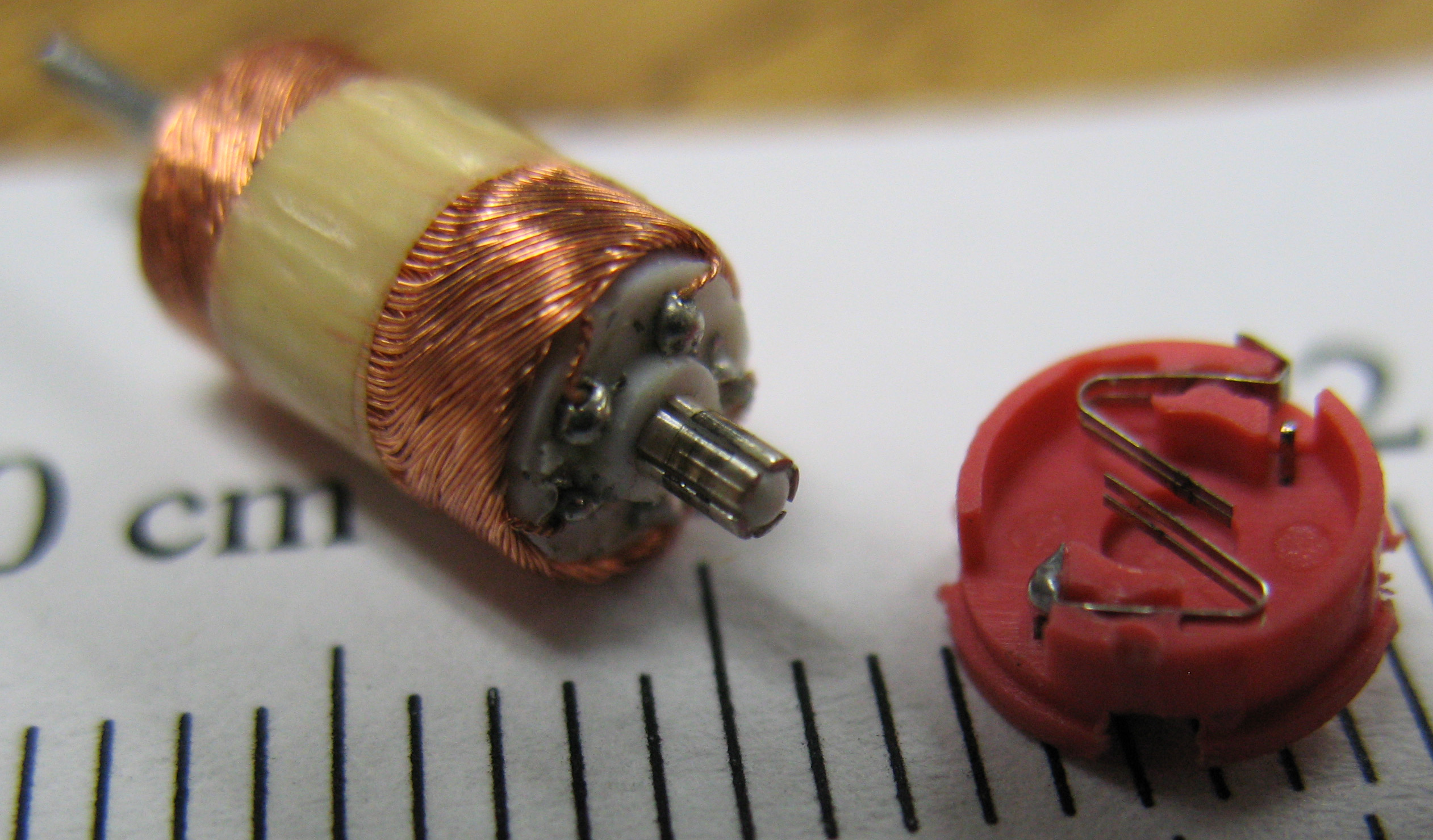|
Mercury Swivel Commutator
A mercury swivel commutator is a connector mainly used in animal experimentation to prevent the twisting of electrode wires attached to moving animals. Application Mercury swivel commutators are typically used in electrophysiological experiments on head-free or moving animals. Whereas electrical recordings from stationary, head-fixed animals can be done with electrodes attached directly with wires to the amplifier and recording setup on a stereotaxtic rig, in freely moving animals a commutator is needed to prevent twisting of the wires attaching the electrode, which moves and rotates with the animal's head (often multiple revolutions in one direction), to the amplifier/recorder, which is in a fixed position. Mechanism A mercury swivel commutator is a type of electrical commutator. These traditionally use slip rings for coupling, which can introduce electrical noise into the connection as the contact points slide over the surface of the slip-rings, causing microscopic bumps whic ... [...More Info...] [...Related Items...] OR: [Wikipedia] [Google] [Baidu] |
Animal Experimentation
Animal testing, also known as animal experimentation, animal research, and ''in vivo'' testing, is the use of animals, as model organisms, in experiments that seek answers to scientific and medical questions. This approach can be contrasted with field studies in which animals are observed in their natural environments or habitats. Experimental research with animals is usually conducted in universities, medical schools, pharmaceutical companies, defense establishments, and commercial facilities that provide animal-testing services to the industry. The focus of animal testing varies on a continuum from pure research, focusing on developing fundamental knowledge of an organism, to applied research, which may focus on answering some questions of great practical importance, such as finding a cure for a disease. Examples of applied research include testing disease treatments, breeding, defense research, and toxicology, including cosmetics testing. In education, animal testing is s ... [...More Info...] [...Related Items...] OR: [Wikipedia] [Google] [Baidu] |
Electrophysiology
Electrophysiology (from [see the Electron#Etymology, etymology of "electron"]; ; and ) is the branch of physiology that studies the electrical properties of biological cell (biology), cells and tissues. It involves measurements of voltage changes or electric current or manipulations on a wide variety of scales from single ion channel proteins to whole organs like the heart. In neuroscience, it includes measurements of the electrical activity of neurons, and, in particular, action potential activity. Recordings of large-scale electric signals from the nervous system, such as electroencephalography, may also be referred to as electrophysiological recordings. They are useful for electrodiagnostic medicine, electrodiagnosis and monitoring (medicine), monitoring. Definition and scope Classical electrophysiological techniques Principle and mechanisms Electrophysiology is the branch of physiology that pertains broadly to the flow of ions (ion current) in biological tissues and, in p ... [...More Info...] [...Related Items...] OR: [Wikipedia] [Google] [Baidu] |
Stereotactic
Stereotactic surgery is a minimally invasive form of surgery, surgical intervention that makes use of a three-dimensional coordinates, coordinate system to locate small targets inside the body and to perform on them some action such as ablation, biopsy, lesion, injection, Deep brain stimulation, stimulation, implantation, radiosurgery (SRS), etc. In theory, any organ system inside the body can be subjected to stereotactic surgery. However, difficulties in setting up a reliable frame of reference (such as bone landmarks, which bear a constant spatial relation to soft tissues) mean that its applications have been, traditionally and until recently, limited to neurosurgery, brain surgery. Besides the brain, biopsy and surgery of the breast are done routinely to locate, sample (biopsy), and remove tissue. Plain X-ray images (radiography, radiographic mammography), computed tomography, and magnetic resonance imaging can be used to Image-guided surgery, guide the procedure. Another acc ... [...More Info...] [...Related Items...] OR: [Wikipedia] [Google] [Baidu] |
Commutator (electric)
A commutator is a rotary switch, electrical switch in certain types of electric motors and electrical generators that periodically reverses the Current (electricity), current direction between the rotor and the external circuit. It consists of a cylinder composed of multiple metal contact segments on the rotating armature (electrical engineering), armature of the machine. Two or more electrical contacts called "brush (electric), brushes" made of a soft conductive material like carbon press against the commutator, making sliding contact with successive segments of the commutator as it rotates. The windings (coils of wire) on the armature (electrical engineering), armature are connected to the commutator segments. Commutators are used in direct current (DC) machines: dynamos (DC generators) and many DC motors as well as universal motors. In a motor the commutator applies electric current to the windings. By reversing the current direction in the rotating windings each half turn, ... [...More Info...] [...Related Items...] OR: [Wikipedia] [Google] [Baidu] |
Slip Ring
A slip ring is an electromechanical device that allows the transmission of Electric power, power and electrical Signal, signals from a stationary to a rotating structure. A slip ring can be used in any Electromechanics, electromechanical system that requires rotation while transmitting power or signals. It can improve mechanical performance, simplify system operation and eliminate damage-prone wires dangling from movable joints. Also called rotary electrical interfaces, rotating electrical connectors, collectors, swivels, or electrical rotary joints, these rings are commonly found in slip ring motors, electrical generators for alternating current (AC) systems and alternators and in packaging machinery, cable reels, and wind turbines. They can be used on any rotating object to transfer power, control circuits, or Analog signal, analog or Digital signal, digital signals including data such as those found on aerodrome beacons, rotating tanks, power shovels, radio telescopes, telemet ... [...More Info...] [...Related Items...] OR: [Wikipedia] [Google] [Baidu] |
Mercury (element)
Mercury is a chemical element; it has Symbol (chemistry), symbol Hg and atomic number 80. It is commonly known as quicksilver. A Heavy metal element, heavy, silvery d-block element, mercury is the only metallic element that is known to be liquid at standard temperature and pressure; the only other element that is liquid under these conditions is the halogen bromine, though metals such as caesium, gallium, and rubidium melt just above room temperature. Mercury occurs in deposits throughout the world mostly as cinnabar (mercuric sulfide). The red pigment vermilion is obtained by Mill (grinding), grinding natural cinnabar or synthetic mercuric sulfide. Exposure to mercury and mercury-containing organic compounds is toxic to the nervous system, immune system and kidneys of humans and other animals; mercury poisoning can result from exposure to water-soluble forms of mercury (such as mercuric chloride or methylmercury) either directly or through mechanisms of biomagnification. Mercu ... [...More Info...] [...Related Items...] OR: [Wikipedia] [Google] [Baidu] |
Neuroscience
Neuroscience is the scientific study of the nervous system (the brain, spinal cord, and peripheral nervous system), its functions, and its disorders. It is a multidisciplinary science that combines physiology, anatomy, molecular biology, developmental biology, cytology, psychology, physics, computer science, chemistry, medicine, statistics, and mathematical modeling to understand the fundamental and emergent properties of neurons, glia and neural circuits. The understanding of the biological basis of learning, memory, behavior, perception, and consciousness has been described by Eric Kandel as the "epic challenge" of the biological sciences. The scope of neuroscience has broadened over time to include different approaches used to study the nervous system at different scales. The techniques used by neuroscientists have expanded enormously, from molecular and cellular studies of individual neurons to imaging of sensory, motor and cognitive tasks in the brain. Hist ... [...More Info...] [...Related Items...] OR: [Wikipedia] [Google] [Baidu] |
Neurophysiology
Neurophysiology is a branch of physiology and neuroscience concerned with the functions of the nervous system and their mechanisms. The term ''neurophysiology'' originates from the Greek word ''νεῦρον'' ("nerve") and ''physiology'' (which is, in turn, derived from the Greek ''φύσις'', meaning "nature", and ''-λογία'', meaning "knowledge"). Neurophysiology has applications in the prevention, diagnosis, and treatment of many neurological and psychiatric diseases. Neurophysiological techniques are also used by clinical neurophysiologists to diagnose and monitor patients with neurological diseases. The field involves all levels of nervous system function, from molecules and cells to systems and whole organisms. Areas of study include: * The electrochemical properties of neurons * Function and regulation of proteins in neurons and glia * Metabolic reactions relevant to neural function * Cell signalling in the nervous system * Neurotransmission and synaptic ... [...More Info...] [...Related Items...] OR: [Wikipedia] [Google] [Baidu] |
Single-unit Recording
In neuroscience, single-unit recordings (also, single-neuron recordings) provide a method of measuring the electro-physiological responses of a single neuron using a microelectrode system. When a neuron generates an action potential, the signal propagates down the neuron as a current which flows in and out of the cell through excitable membrane regions in the soma and axon. A microelectrode is inserted into the brain, where it can record the rate of change in voltage with respect to time. These microelectrodes must be fine-tipped, impedance matching; they are primarily glass micro-pipettes, metal microelectrodes made of platinum, tungsten, iridium or even iridium oxide. Microelectrodes can be carefully placed close to the cell membrane, allowing the ability to record extracellularly. Single-unit recordings are widely used in cognitive science, where it permits the analysis of human cognition and cortical mapping. This information can then be applied to brain–machine interfa ... [...More Info...] [...Related Items...] OR: [Wikipedia] [Google] [Baidu] |
Mercury Switch
A mercury switch is an electricity, electrical switch that opens and closes a electrical circuit, circuit when a small amount of the liquid metal mercury (element), mercury connects metal electrodes to close the circuit. There are several different basic designs (tilt, displacement, radial, etc.) but they all share the common design strength of non-eroding switch contacts. The most common is the ''mercury tilt switch''. It is in one state (open or closed) when tilted one direction with respect to horizontal, and the other state when tilted the other direction. This is what older style thermostats used to turn a heater or air conditioner on or off. The ''mercury displacement switch'' uses a 'plunger' that dips into a pool of mercury, raising the level in the container to contact at least one electrode. This design is used in relays in industrial applications that need to switch high current loads frequently. These relays use electromagnetic coils to pull steel sleeves inside her ... [...More Info...] [...Related Items...] OR: [Wikipedia] [Google] [Baidu] |
Electrophysiology
Electrophysiology (from [see the Electron#Etymology, etymology of "electron"]; ; and ) is the branch of physiology that studies the electrical properties of biological cell (biology), cells and tissues. It involves measurements of voltage changes or electric current or manipulations on a wide variety of scales from single ion channel proteins to whole organs like the heart. In neuroscience, it includes measurements of the electrical activity of neurons, and, in particular, action potential activity. Recordings of large-scale electric signals from the nervous system, such as electroencephalography, may also be referred to as electrophysiological recordings. They are useful for electrodiagnostic medicine, electrodiagnosis and monitoring (medicine), monitoring. Definition and scope Classical electrophysiological techniques Principle and mechanisms Electrophysiology is the branch of physiology that pertains broadly to the flow of ions (ion current) in biological tissues and, in p ... [...More Info...] [...Related Items...] OR: [Wikipedia] [Google] [Baidu] |





